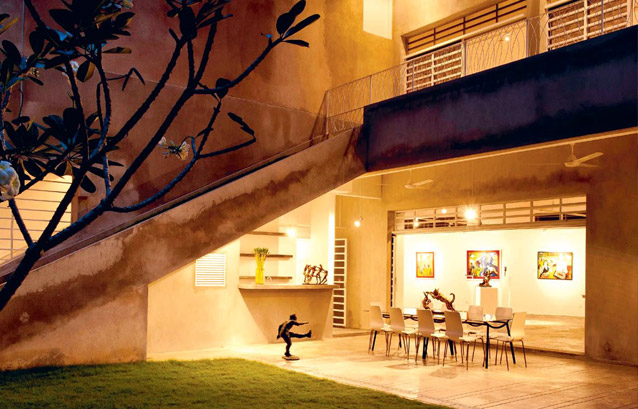Above: The gallery brings the outdoors into the space in a subtle way. opposite LEFT | The angular form of the gallery residence integrates strips of lawn into its design.
You get a sense of wonder when you first meet Shalini Ganendra. Calm, yet powerful, her personality shines and her eyes light up at the mere mention of art. And, she is very specific about quality.
“I am very much drawn to artists who have dedicated their life and passion to creating quality art that reflects cerebral depth and good technique. Those elements show,” she says.
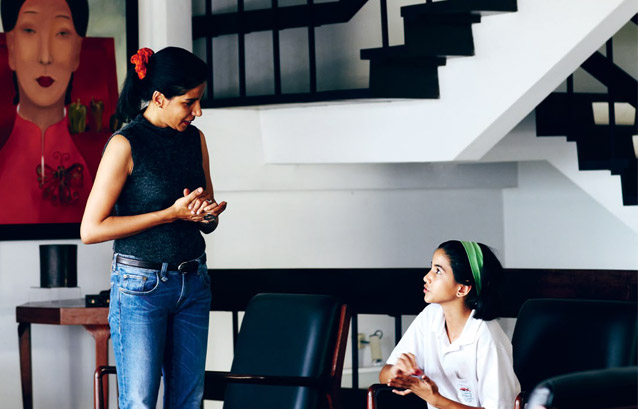
Shalini ganendra at home with her daughter Juliana.
Born in Sri Lanka, Shalini lived in the United States and United Kingdom before settling in Malaysia with her engineer husband, Dennis Ganendra. A financial lawyer by trade, who has practised in New York, she brings a fresh perspective to art, combining financial and legal acumen with a natural inclination to art nurtured since childhood by her grandparents and her parents. Having lived with art from a young age, she found herself happily making it a vocation later in life.
When the opportunity came up in 1998, five years after she came to Malaysia, Shalini set up independent exhibition and cultural space, Shalini Ganendra Fine Art, or SGFA, (which was then known as The Private Gallery). The gallery specialises in contemporary art and design and has a focus on art from emerging regions, such as Malaysia and Sri Lanka. She is also pleased that SGFA presented the first aboriginal art exhibition in the region by artists from Elcho Island.
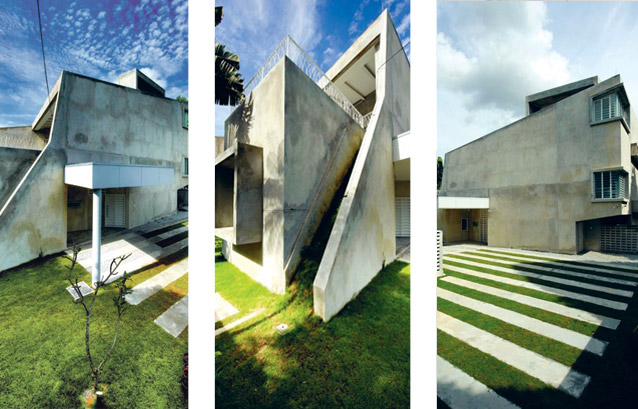
Left: The angular form of the gallery residence integrates strips of lawn into its design. opposite
Middle: The residence has a clean, bare concrete facade. opposite
Right: The side of the Residence and its well manicured lawn, laid out in strips, leads the eye towards the building that was designed by Ken Yeang.
As The Private Gallery’s audience grew, a purpose-designed venue was needed to accommodate public programming, gallery projects and a swelling exhibition calendar. So, in January 2011, Shalini unveiled SGFA’s new public ‘residence’ in a bungalow nestled in the Kuala Lumpur satellite city, Petaling Jaya.
A visit to SGFA’s new Gallery Residence, designed by Malaysian architectural luminary, Ken Yeang, is a treat in the hot, humid climate of Kuala Lumpur. Walking through this green space, the air is fresh, breezy and cool, from the ground floor all the way to the second.
Like a Möbius strip, the house is seamlessly connected – a trajectory of experiences from one room to another that is almost boundless in nature.
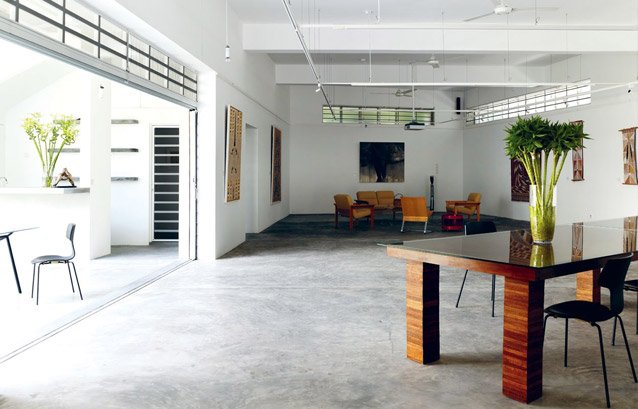
The ground floor of the gallery is spacious and airy, with air vents that allow cross circulation.
Shalini says, “We had a very clear vision of the aesthetic for SGFA’s Gallery Residence, and Ken realised that vision.” The construction of the house took a mere 10 months, on account of the rigorous efforts of project manager and engineering consultant, Minconsult Sdn Bhd. The quality of its design has already led to the Gallery winning an Architectural Excellence Award from the Malaysian Institute of Architects (PAM) in 2011.
Shalini enthuses, “We chose Ken for this project because of his notable experience and contribution to green architecture. You can see his theories come to life in the Gallery.” She points out the wind chimney that draws air down into the gallery space and circulates it throughout the house.
Rainwater bioswales (landscape elements designed to remove silt and pollution from surface run-off water), locally sourced materials and an energy-efficient design have given the house a dynamic environment.
Accommodation for visiting artists and interns, along with a supplementary exhibition space, is located upstairs, while the ground floor houses the main exhibition space, an artist’s studio, resource centre/office and the courtyard garden.
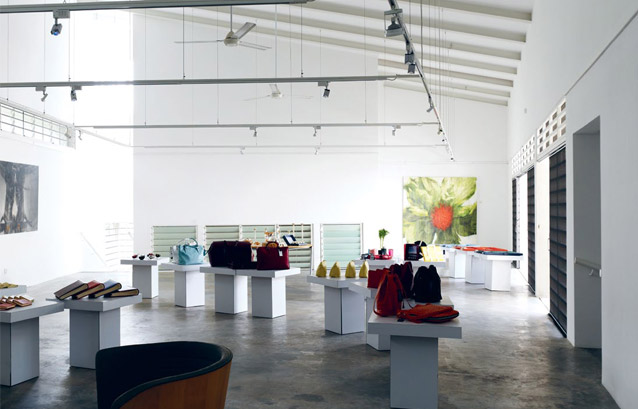
A view of the gallery’s upper floor, with high ceilings to dissipate heat.
The exterior of the building has been kept clean and well manicured, and includes strips of vegetation, and its grass ramps are a Ken Yeang hallmark.
“It was important to continue the theme of living with art, so the public space had to be in a residential setting. It was also important to have a space that spoke to memorable design, that was a work of art in itself.
“We encourage our visitors to immerse themselves in the experience of living with art, collecting for the sake of enjoyment – and we know that all else (good investment, good interior/style) will follow from that fundamental principle,” Shalini observes.
She also organises lectures. Currently in its third year, SGFA’s Vision Culture Lectures series is an innovative program that brings international art luminaries to Malaysia to speak at free events at SGFA.
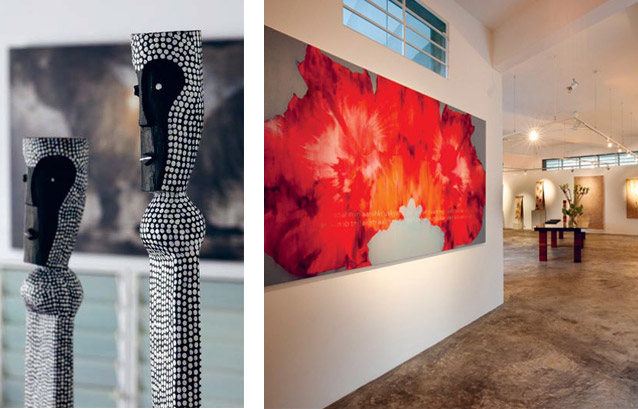
Left: Sculptures by award winning aborginal artist, Jeremiah Bonson.
Right: Entrance Foyer to Ganendra Art House showing the commissioned Celebrations Table (canvas, glass, recycled hardwood) by Dennis Chan and Origins Chandelier (ceramic) by Lileng Wong (photo by See Kwong Chong).
The lectures have been hugely successful, attracting big names, such as Christopher Phillips, the curator at the International Center of Photography in New York; University of Queensland’s Pacific art expert Dr Susan Cochrane; photographer with the Magnum agency, Antoine d’Agata; and British surgeon and painter, Sir Roy Calne – as well as growing local audiences.
“We really appreciate the response and support for this program. Asia is so keen to learn more about cross-cultural practises, and our speakers are eager to learn about South- East Asia, so we provide a credible bridging mechanism,” Shalini says.
A new artist-residency program, the Vision Culture Artist Residency, will launch this year with a focus on encouraging artistic dialogue between artists from east and west. “The space has allowed us to grow and expand with positive vigour and great imagination,” she says.

Shalini’s home is filled with favourite family photographs, the earliest dating from the late 1800’s.
“SGFA encourages collecting with a cosmopolitan perspective – we ask collectors to look at the best in Malaysia and then beyond to pick and choose the best internationally. With art and design, there are no geographical boundaries. There is great freedom to choose with good guidance,” she adds.
A look around the current exhibits at the gallery provides testament to SGFA’s eclectic Shalini Ganendra | shaliniganendra.com vision. A selection of pieces celebrating contemporary British design by William & Son is in the upstairs gallery, complemented by huge hibiscus oil/jute canvases by the Malaysian Zac Lee. The ground floor shows off a selection of award-winning aboriginal artists from Elcho Island off the Northern Territory in Australia.

The living room in Shalini’s home features a mix of vintage and modern furniture.
“SGFA represents mid-career and senior artists, and we are very involved in curating the best shows by the best artists, with their best works.
“This practise has reinforced the credibility of the exhibitions and naturally lends support to the added bonus of investment value,” Shalini says.
With so many things in the pipeline for SGFA, when asked what keeps her energy up, Shalini, who has children aged 16, 15, and 10, exclaims, “Seeing more magic happen in this wonderful green Gallery Residence!”
About the House:
The two-storey building was designed by T.R. Hamzah and Yeang. Just over 63% of the building is devoted to gallery space with a total floor area of 633.4m2. Orientation and fenestration are designed to minimise solar heat gain. Other ecological design features include:
• The wind chimney, a 360º vertical wind shaft distributing a down-draft throughout the house, controlled by operable glass louvres at the base.
• Landscaping designed to maximise greenery to reduce heat island effect
• Bioswales to absorb, collect and clean surface run-off
• Cross-ventilation to supplement the benefits of the wind chimney
• Indirect day lighting
• Sun-shading devices
• Use of environmentally friendly materials and finishes
Text: Amy Ng
Photography: Derek Swalwell
derekswalwell.com
Shalini Ganendra Fine Art
shaliniganendra.com

